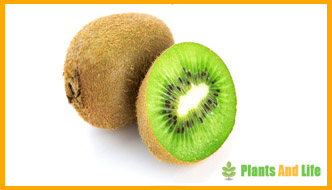
Kiwis are fruits of several species of creepers of the genus Actinidia, family of Actinidiaceae. They are from China, especially from Shaanxi province. They are also found in so-called tropical mountain climates. In France, the Adour kiwis have a PGI and a red label.
Its generally green, sweet and tart pulp, surrounded by a brown and fluffy (hairy) skin, contains a hundred tiny edible black seeds. Kiwi is a source of vitamin C, but also vitamin A and E, calcium, iron and folic acid.
There are different species, such as Actinidia chinensis, Actinidia deliciosa, kiwai (Actinidia arguta), arctic kiwi, etc.
Other vernacular names of kiwi are among others: Chinese gooseberry, Yang Tao (Chinese name), Plant mouse (not to be confused with the Mouse plant), Chinese actinide (translation of the scientific name), or even Actinidier (in nurserymen ).
Composition
Nutritional values
Kiwi fruit contains more vitamin C than orange; it also provides vitamin E contained in its black seeds or provitamin A, and B1, B2, B3, B5 and B6. It provides approximately 61 kilocalories (255 kilojoules) per 100 grams. It is rich in potassium, its magnesium level is high. Iron, copper, zinc and phosphorus are also found there. Therefore, kiwi is one of the fruits with the highest antioxidant activity.
Culture
Actinidia appreciate deep, light, well-drained soils with a pH between 6.0 and 6.5 with a sunny exposure sheltered from the wind. The plant is sensitive to cold (-10 to −15 ° C depending on the variety, while the Kiwaï tree can resist up to −30 ° C).
Pollination of kiwis is difficult because their flowers are not very attractive to bees. Some producers artificially pollinate with harvested pollen and others place hives in the fields to optimize the chances of pollination.
Since the 1990s, we have found hermaphroditic plants which theoretically allow us to grow only "productive" feet.
 Intensification of culture
Intensification of cultureThe plant was first cultivated in domestic gardens, but commercial planting began in 1934 in New Zealand, which began exporting Actinidia in 1953. By selection, New Zealanders obtained varieties producing large fruits size (over 100 grams).
In 1935, a plant was imported to California, initiating a new production area.
The high vitamin C content of Actinidia was known in the 1940s. We can read about this in the Bulletin of the Scientific Society of Food Hygiene and Rational Food for Man in 1944: One of the most interesting fruits is the "vegetable mouse", produced by the Actinidia chinensis, a creeper from China perfectly hardy in our climate. " However, it is further said that this fruit constitutes "a rarity, which will require a certain number of years before being sufficiently widespread". This passage also testifies to an ephemeral appellation which was the object of the kiwi. It is found at least until 1971, as evidenced by the Bulletin of the Central Horticultural Society of Nancy this year; the passage speaks of the fruit only under this denomination, insisting on the resemblance to the animal: "As you see, the fruit resembles a mouse or more exactly a small vole that we meet frequently in cultures. "
In the 1960s, a French architect stationed in China, Jacques Rabinel, brought back some fruit that had been offered to him. He presents them to the manager of the Jardin des Plantes in Paris. Shortly after, he was the first French supplier of plants in Pessac-sur-Dordogne in Gironde.

